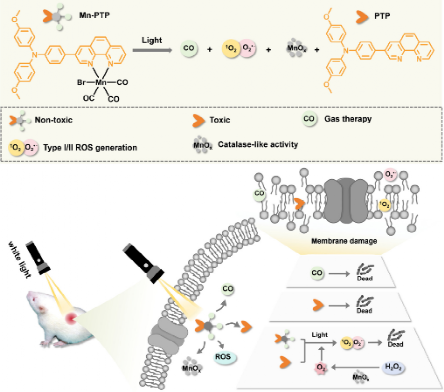First transition metals are not only abundant on Earth but also function as essential trace elements for the human body, exhibiting good biocompatibility. Professor Pingyu Zhang's team has recently designed a series of first transition metal-based small molecule drugs with diverse functions for treating tumors and bacterial infections. These drugs are characterized by their distinct structures, ease of reproduction, good bio-safety, and significant potential for clinical transformation.
Tuberculosis, a globally significant infectious disease caused by Mycobacterium tuberculosis, poses a major challenge due to the growing issue of drug resistance, which greatly reduces the efficacy of traditional drugs. Consequently, there is an urgent need to develop novel multi-target treatment approaches. Photo-activated therapy and gas-based therapy have emerged as promising antibacterial strategies. However, nano-carrier-based multi-component drugs currently face several challenges, including complex preparation processes, poor stability, and unclear pharmacokinetics. Developing a small molecule metal complex capable of both photo-activity and carbon monoxide (CO) release could offer a new approach to overcome bacterial drug resistance. By leveraging the synergistic effects of these two functions to disrupt bacterial structures, such a complex holds promise for tuberculosis treatment.
The research team has developed a novel “all-in-one” photo-activated manganese-based CO-releasing molecule (Mn-PTP) for the synergistic treatment of mycobacterial infections. Under white light irradiation, Mn-PTP can simultaneously generate Type I and Type II reactive oxygen species (ROS), release CO, produce manganese oxides (MnOx) with catalase-like activity, and release the antibacterial ligand PTP (Figure 1). Additionally, the manganese in the complex can be converted into manganese oxides, which catalyze the decomposition of hydrogen peroxide (H₂O₂) within bacteria into oxygen (O₂). This action alleviates hypoxic conditions, promotes the generation of Type I ROS, and further enhances antibacterial effects. In the dark, Mn-PTP exhibits good stability and demonstrates excellent bactericidal effects against Mycobacterium smegmatis at low doses, effectively clearing its biofilm. In vivo experiments revealed that mice infected with M. smegmatis and treated with Mn-PTP in combination with white light irradiation showed significantly faster wound healing. This confirms that Mn-PTP has a dual role in suppressing bacterial growth and promoting tissue repair (Figure 2). Moreover, Mn-PTP exhibits good bio-safety towards normal cells in the dark.
This work offers a new approach for tuberculosis treatment and contributes to the development of antibacterial drugs, providing a potential solution to global public health challenges.

Figure 1. Schematic diagram of the carbonyl manganese complex for anti-mycobacterial use.

Figure 2. Efficacy of wound treatment in mice.
This achievement, titled "One-for-All Photoactivatable Manganese-Based Carbon Monoxide-Releasing Molecules (CORMs) for Synergistic Therapy of Mycobacterial Infection," was published in the Journal of the American Chemical Society (DOI: 10.1021/jacs.5c05490). The first authors are Shenzhen University graduate students Yingru Lai and Liu Wang, with corresponding authors being Professor Zhang Pingyu from Shenzhen University and Professor Huang Huaxi from Sun Yat-sen University. Shenzhen University is the first completing unit.
In addition to manganese, Professor Zhang's team has also explored the bioactivity of other first transition metals, such as zinc. They developed a photo-isomerizable zinc (II) complex, Zn1, which releases a cis-toxic ligand and generates ROS under blue light irradiation to effectively kill hypoxic tumor cells with good bio-safety. This achievement provides a new solution to address the oxygen dependence of traditional photodynamic therapy (Angew. Chem. Int. Ed. 2023, e202301344). The team also developed a zinc complex based on hydrazone ligands, ZnAMTC. When activated by ultrasound, this complex generates ROS and induces ferroptosis, thereby efficiently inhibiting tumor growth while demonstrating good bio-safety (Chem. Sci. 2024, 15, 10027). These studies indicate that biocompatible first transition metals hold broad application prospects in cancer treatment and antibacterial infections.
